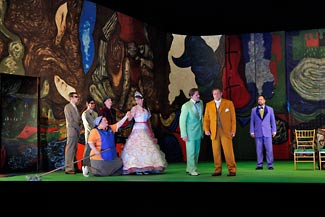
Griselda – The Harried Wife and Peter Sellars – The Great Director
Griselda, the tale from which Vivaldi’s Opera (and its brilliant new interpretation by director Peter Sellars and conductor Grant Gershon at Santa Fe Opera) derives, is an old one: 14th century, from Bocaccio’s Decameron, with an overlay of Canterbury Tales and wives harried beyond measure.
 Griselda (Meredith Arwady) is a commoner who marries a prince; the people of Thessaly despise her low birth. Consequently, her husband, Gualtiero (Paul Groves), puts her through torments, which ultimately prove her heart-purity, and conclude the story on a restoration-of-the-republic note.
Griselda (Meredith Arwady) is a commoner who marries a prince; the people of Thessaly despise her low birth. Consequently, her husband, Gualtiero (Paul Groves), puts her through torments, which ultimately prove her heart-purity, and conclude the story on a restoration-of-the-republic note.
The SFO program has gone to some pains to paint the contemporary conflicts of telling this story – what gives Griselda the gumption not to just go drown herself in all the bad weather metaphors? But if one reads Peter Sellars’ version of this opera for contemporaneity, Griselda’s forbearance is elliptical at the end: That final mop-swish (she was turned into a maid in Act 3) wonders if the future is all smooth waters or portends mood indigo for an awful husband? I enjoyed musing on Griselda the sequel.
Back to this opera – and its history of castrati (now counter-tenors) and Baroque music meeting the story’s inciting medieval poetry.
Baroque in texture (and composition), rich in grandly sung arias, Griselda, this Griselda, surely can’t be called minimalist – but its means are indeed streamlined. To tremendous effect Peter Sellars has placed his players – a cast of just six – into a very intimate situation in which not even costumes are changed by the leads over the three acts. And the characters have no place to sit, lie or fall. There is one chair onstage only; there is no other furniture. This creates a very lean situation for the singers who have to go to their bodies for the pain and conflict – and the actual edge and floor of the stage . Griselda prone and prostrate is an outcast who manages never to despise the power who is punishing her. Her admirer, Ottone (Amanda Majeski), was a stunner of the cast – a woman playing a man with a flashy switchblade aesthetic.
And: The Opera is pretty funny at the front. Griselda as tossed ship of tribulations, unwelcome really anywhere, may be a sad story, but Sellars has lightened up on the pathos at first, at least. Not least among the sufferings of the demoted wife, are bawdy sexual agendas announced subtly but potently in Gualtiero’s stallion-ish cut of pants and leather thigh-highs. The plot moves rather quickly toward the part of the ruse in which Gualtiero, having rejected Griselda, is going to marry their own beautiful daughter, Costanza (Isabel Leonard), whom Griselda hasn’t seen since she was a wee tot. There may be no Electra-ish bodice-ripping but there is a decided bodice (costumes by Slovakian designer Dunya Ramicova) in the form-fitting part of lovely Costanza’s gown, whose pink-frilled skirt speaks to at least suggested innocence underlying the provocative effect. Costanza loves Roberto (David Daniels) – and Corrado (Yuri Minenko) plays the Gualtiero go-between.

David Daniels Plays Roberto in Griselda at SFO
I am reflecting, as I sit to write this review, that another of the best operas I have seen was a small regional company from Russia in a New York venue in 1990. It was a very low budget Boris Godunov that knew from serfs. The corps stayed on stage the entire time moving as a stolid body throughout the opera’s entirety. You just sat transfixed by the reality of large bodies quiet yet there, communicating the inextricability of ruler and ruled.
Consider Griselda now, at SFO, an occasion to reflect likewise on how great opera requires time-travel packed with potency. Sellars and his supporting cast – particularly, the amazingly fantastic set by artist Gronk and lighting design by James Ingalls – deals in themes of subjugated in a local way. Gronk painted the set in place: 12-foot panels wrap around the bare stage. (He also has done a mural at Albuquerque Museum.) The colors are expressionist reds, greens, blues, browns. You can read them for landscape and for symbol: petroglyph-shapes, crowns, rocks, clouds that are fireclouds, and faces, which flicker like figments of a warped mirror. As doors open into the unseen a seafaring white light beams in as if to suggest the Emily Dickinson line about knowing the transport from the pain.
By Act 2, wrapped in a blanket in her exile, Griselda sports an Indian blanket. At the time of her re-appointment to Gualtieri’s honored wife and princess, she also wears native-adornment, reflecting Sellars and costume designer, commenting that reinstatement can involve these parts of speech : “In-stating,” restoring what is most native, local and true.

Gronk seated in Griselda set
I loved this opera. Wonderful singing, a set to reflect on through all turns of the plot, and a terrific cast. Don’t you all believe reviews that complain about lost histories. For who of us was really there in 1735? Peter Sellars has been a beacon to making opera new and this one deserves shouting bravos at.
Griselda will also be performed on July 29, August 4, 9 and 19. For tickets visits santafeopera dot org.

Thank you for this lovely review. I simply can’t understand the criticism (indeed, sometimes the derision) that this performance has evoked. We loved it. We know the opera pretty well, but thought that Sellars’s brilliant staging gave it multiple additional layers of meaning. Bravo, Mr. Sellars, and brava to you for this discussion.